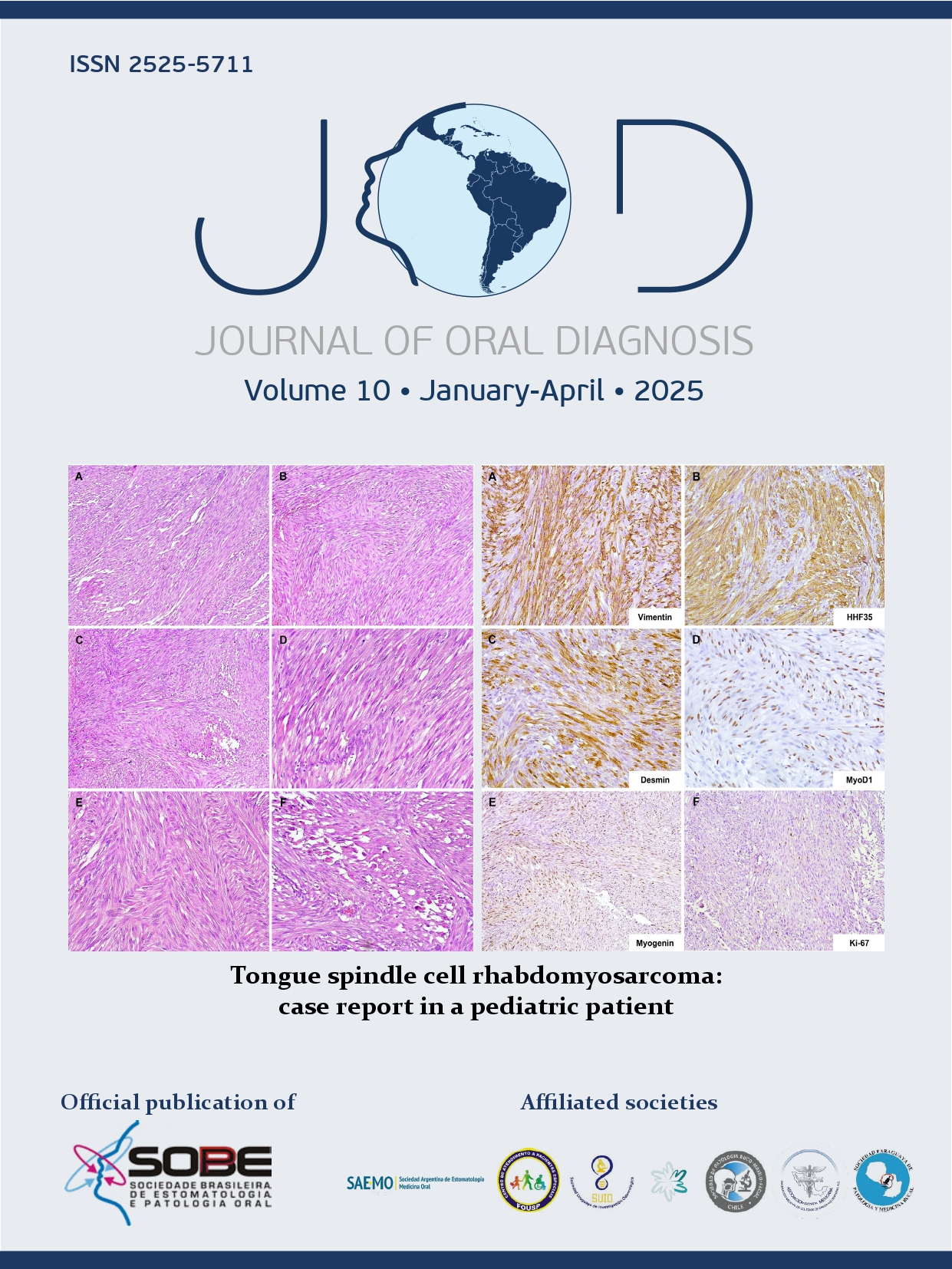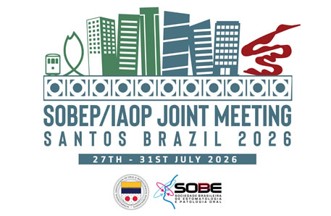Oral Leishmaniasis: diagnostic and therapeutic journey
DOI:
https://doi.org/10.5327/2525-5711.303Palabras clave:
Leishmaniasis, mucocutaneous, Oral manifestations, Diagnostics, Case reportsResumen
Leishmaniasis, caused by protozoan parasites, is a widespread infectious disease and a prominent example of neglected tropical diseases. Brazil is among the countries most severely affected by this condition globally. Mucocutaneous leishmaniasis rarely involves oral sites, presenting diagnostic challenges. This study explores a case of mucocutaneous leishmaniasis discussing clinical presentation, diagnostic process and treatment. An 85-year-old woman presented with a progressively enlarging, painful palatal ulcer. The patient had a history of treated tuberculosis and reported additional symptoms including breathing difficulties, nosebleeds, osteoarthritis, hearing loss, and insomnia. Initial biopsy showed ulcerated squamous epithelium and nodular granulomatous inflammation. Despite negative diagnostic tests for tuberculosis, syphilis, HIV, and viral hepatitis, sarcoidosis was initially considered but treatment was ineffective. Worsening symptoms later revealed structures consistent with Leishmania sp. amastigote forms, confirmed by immunohistochemistry, leading to a diagnosis of oral leishmaniasis. Treatment with liposomal amphotericin B resulted in successful management. The rarity of oral manifestations further complicates diagnosis, highlighting the critical role of dentists in conducting a thorough assessment, administering the correct treatment, and ensuring proper follow-up to guarantee patient compliance.
Citas
World Health Organization. Leishmaniasis status of endemicity of cutaneous leishmaniasis: 2022 [Internet]. Geneva: World Health Organization; 2022 [cited 2024 June 15]. Available from: https://apps.who.int/neglected_diseases/ntddata/leishmaniasis/leishmaniasis.html
Burza S, Croft SL, Boelaert M. Leishmaniasis. Lancet. 2018;392(10151):951-70. https://doi.org/10.1016/s0140-6736(18)31204-2
Borghi SM, Fattori V, Conchon-Costa I, Pinge-Filho P, Pavanelli WR, Verri Jr WAV. Leishmania infection: painful or painless? Parasitol Res. 2017;116(2):465-75. https://doi.org/10.1007/s00436-016-5340-7
Bastidas GA. Contribuciones de la epidemiología al control de la leishmaniosis. Rev Salud Pública. 2019;21(4):472-5. https://doi.org/10.15446/rsap.V21n4.74866
Muvdi-Arenas S, Ovalle-Bracho C. Mucosal leishmaniasis: a forgotten disease, description and identification of species in 50 Colombian cases. Biomedica. 2019;39(Supl. 2):58-65. https://doi.org/10.7705/biomedica.v39i3.4347
Yadav P, Azam M, Ramesh V, Singh R. Unusual observations in Leishmaniasis-an overview. Pathogens. 2023;12(2):297. https://doi.org/10.3390/pathogens12020297
Santos RLO, Tenório JR, Fernandes LG, Ribeiro AIM, Costa SAP, Trierveiler M, et al. Oral leishmaniasis: report of two cases. J Oral Maxillofac Pathol. 2020;24(2):402. https://doi.org/10.4103/jomfp.JOMFP_306_18
Montaner-Angoiti E, Llobat L. Is leishmaniasis the new emerging zoonosis in the world? Vet Res Commun. 2023;47(4):1777-99. https://doi.org/10.1007/s11259-023-10171-5
Camargo RA, Nicodemo AC, Sumi DV, Gebrim EMMS, Tuon FF, Camargo LM, et al. Facial structure alterations and abnormalities of the paranasal sinuses on multidetector computed tomography scans of patients with treated mucosal leishmaniasis. PLoS Negl Trop Dis. 2014;8(7):e3001. https://doi.org/10.1371/journal.pntd.0003001
Silveira HA, Panucci BZM, Silva EV, Mesquita ATM, León JE. Microscopical diagnosis of oral leishmaniasis: kinetoplast. Head Neck Pathol. 2021;15(3):1085-6. https://doi.org/10.1007/s12105-021-01304-w
Alsibai KD, Couppié P, Blanchet D, Adenis A, Epelboin L, Blaizot R, et al. Cytological and histopathological spectrum of histoplasmosis: 15 years of experience in French Guiana. Front Cell Infect Microbiol. 2020;10:591974. https://doi.org/10.3389/fcimb.2020.591974
Bamorovat M, Sharifi I, Afshari SAK, Karamoozian A, Tahmouresi A, Heshmatkhah A, et al. Poor adherence is a major barrier to the proper treatment of cutaneous leishmaniasis: a case-control field assessment in Iran. Int J Parasitol Drugs Drug Resist. 2023;21:21-7. https://doi.org/10.1016/j.ijpddr.2022.11.006
Adler-Moore J, Lewis RE, Brüggemann RJM, Rijnders BJA, Groll AH, Walsh TJ. 2019. Preclinical safety, tolerability, pharmacokinetics, pharmacodynamics, and antifungal activity of liposomal amphotericin B. Clin Infect Dis. 2019;68(Suppl 4):S244-S259. https://doi.org/10.1093/cid/ciz064
Pradhan S, Schwartz RA, Patil A, Grabbe S, Goldust M. Treatment options for leishmaniasis. Clin Exp Dermatol. 2022;47(3):516-21. https://doi.org/10.1111/ced.14919
Chivinski J, Nathan K, Naeem F, Ekmekjian T, Libman MD, Barkati S. Intravenous Liposomal amphotericin B efficacy and safety for cutaneous and mucosal leishmaniasis: a systematic review and meta-analysis. Open Forum Infect Dis. 2023;10(7):ofad348. https://doi.org/10.1093/ofid/ofad348
Descargas
Publicado
Cómo citar
Número
Sección
Licencia
Derechos de autor 2025 Sonia Maria Soares Ferreira, Catarina Rodrigues Rosa de Oliveira, Glória Maria de França, Eulina Maria Vieira de Abreu, Ivisson Alexandre Pereira da Silva, Anne Caroline Barbosa dos Santos, João Carlos de Melo Araújo, Nicole Lonni, Caroline Alfaia Silva, Elena Riet Correa Rivero, Rogério de Oliveira Gondak, Ricardo Luiz Cavalcanti de Albuquerque-Júnior

Esta obra está bajo una licencia internacional Creative Commons Atribución 4.0.













